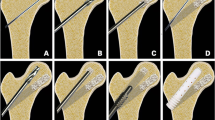Abstract
Purpose
Patients with neuro-orthopaedic disorders often develop hip flexion contractures or rotational hip deformities. Increasing deformities impair the already diminished walking abilities and proximal femoral osteotomies are often performed to maintain/improve walking abilities. Fixation of the osteotomies with condylar plates has been successfully used but does often not allow immediate postoperative full weight bearing. To avoid a substantial postoperative rehabilitation deficit and additional bone loss due to inactivity, a postoperative treatment with full weight bearing is, therefore, wishful. Newer fixed-angled implants with stronger anchoring in osteopenic bone might fit these demands. The objective of this study was to evaluate bone healing and the complication rate after proximal extending and/or derotational femoral osteotomy fixed with 3.5/4.5 Locking Compression Plate (LCP; Synthes®) and postoperative full weight bearing in ambulatory neuro-orthopaedic patients.
Methods
Fifteen ambulatory neuro-orthopaedic patients (12 cerebral palsy [CP], 1 trisomy 21, 2 hemiparesis) with a mean age of 13.7 years (range 7–22) with hip flexion contractures and/or rotational deformities underwent subtrochanteric (n = 26) osteotomy between July 2004 and October 2007. All patients were allowed to bear their full weight postoperatively. We investigated the fusion rate, implant failure, and general complication rate until union had occurred.
Results
Fourteen patients (mean weight 42.0 kg [range 21.8–59]) uneventfully achieved solid fusion. One patient (19 years of age, 73 kg) needed revision surgery due to implant failure with consecutive varus deformity and achieved solid fusion after the second intervention. Besides one superficial wound infection, no other complications occurred.
Conclusions
Subtrochanteric extending and/or derotational osteotomies fixed with an LCP are a reliable procedure in neuro-orthopaedic patients. Most patients can be treated with early postoperative full weight bearing. However, in heavier patients, possible implant failure must be considered.


Similar content being viewed by others
References
Bobroff ED, Chambers HG, Sartoris DJ, Wyatt MP, Sutherland DH (1999) Femoral anteversion and neck–shaft angle in children with cerebral palsy. Clin Orthop Relat Res (364):194–204
O’Sullivan R, Walsh M, Hewart P, Jenkinson A, Ross LA, O’Brien T (2006) Factors associated with internal hip rotation gait in patients with cerebral palsy. J Pediatr Orthop 26(4):537–541
Hoffer MM, Knoebel RT, Roberts R (1987) Contractures in cerebral palsy. Clin Orthop Relat Res (219):70–77
Pin T, Dyke P, Chan M (2006) The effectiveness of passive stretching in children with cerebral palsy. Dev Med Child Neurol 48(10):855–862
Arnold AS, Delp SL (2001) Rotational moment arms of the medial hamstrings and adductors vary with femoral geometry and limb position: implications for the treatment of internally rotated gait. J Biomech 34(4):437–447
Tylkowski CM, Rosenthal RK, Simon SR (1980) Proximal femoral osteotomy in cerebral palsy. Clin Orthop Relat Res (151):183–192
Kay RM, Rethlefsen SA, Hale JM, Skaggs DL, Tolo VT (2003) Comparison of proximal and distal rotational femoral osteotomy in children with cerebral palsy. J Pediatr Orthop 23(2):150–154
Henderson RC, Lark RK, Gurka MJ, Worley G, Fung EB, Conaway M, Stallings VA, Stevenson RD (2002) Bone density and metabolism in children and adolescents with moderate to severe cerebral palsy. Pediatrics 110(1 Pt 1):e5
Henderson RC, Lin PP, Greene WB (1995) Bone-mineral density in children and adolescents who have spastic cerebral palsy. J Bone Joint Surg Am 77(11):1671–1681
Quan A, Adams R, Ekmark E, Baum M (1998) Bone mineral density in children with myelomeningocele. Pediatrics 102(3):E34
Kao CH, Chen CC, Wang SJ, Yeh SH (1992) Bone mineral density in children with Down’s syndrome detected by dual photon absorptiometry. Nucl Med Commun 13(10):773–775
Schaefer MK, McCarthy JJ, Josephic K (2007) Effects of early weight bearing on the functional recovery of ambulatory children with cerebral palsy after bilateral proximal femoral osteotomy. J Pediatr Orthop 27(6):668–670
Palisano R, Rosenbaum P, Walter S, Russell D, Wood E, Galuppi B (1997) Development and reliability of a system to classify gross motor function in children with cerebral palsy. Dev Med Child Neurol 39(4):214–223
Duwelius PJ, Schmidt AH, Rubinstein RA, Green JM (1995) Nonreamed interlocked intramedullary tibial nailing. One community’s experience. Clin Orthop Relat Res (315):104–113
Keating JF, O’Brien PJ, Blachut PA, Meek RN, Broekhuyse HM (1997) Locking intramedullary nailing with and without reaming for open fractures of the tibial shaft. A prospective, randomized study. J Bone Joint Surg Am 79(3):334–341
Voutsinas S, Anagnostopoulos D, Papadopoulos H, Moutzouris T, Iliopoulos S (1997) Internal fixation of hip osteotomy in children. Successful healing in 26 children without postoperative casting. Acta Orthop Scand Suppl 275:106–107
Wilkinson AJ, Nattrass GR, Graham HK (2001) Modified technique for varus derotation osteotomy of the proximal femur in children. ANZ J Surg 71(11):655–658
Szalay EA, Harriman D, Eastlund B, Mercer D (2008) Quantifying postoperative bone loss in children. J Pediatr Orthop 28(3):320–323
Parsch K (1991) Origin and treatment of fractures in spina bifida. Eur J Pediatr Surg 1(5):298–305
Stasikelis PJ, Lee DD, Sullivan CM (1999) Complications of osteotomies in severe cerebral palsy. J Pediatr Orthop 19(2):207–210
Sturm PF, Alman BA, Christie BL (1993) Femur fractures in institutionalized patients after hip spica immobilization. J Pediatr Orthop 13(2):246–248
Huber H, Haefeli M, Dierauer S, Ramseier LE (2009) Treatment of reduced femoral antetorsion by subtrochanteric rotational osteotomy. Acta Orthop Belg 75(4):490–496
Snow M, Thompson G, Turner PG (2008) A mechanical comparison of the locking compression plate (LCP) and the low contact-dynamic compression plate (DCP) in an osteoporotic bone model. J Orthop Trauma 22(2):121–125
Stoffel K, Dieter U, Stachowiak G, Gächter A, Kuster MS (2003) Biomechanical testing of the LCP—how can stability in locked internal fixators be controlled? Injury 34(Suppl 2):B11–B19
Acknowledgements
No funding has been received for this work. There are no financial conflicts of interest between any of the authors and the nature of this work.
Author information
Authors and Affiliations
Corresponding author
About this article
Cite this article
Haefeli, M., Huber, H., Dierauer, S. et al. Fixation of subtrochanteric extending/derotational femoral osteotomies with the Locking Compression Plate in ambulatory neuro-orthopaedic patients. J Child Orthop 4, 423–428 (2010). https://doi.org/10.1007/s11832-010-0281-7
Received:
Accepted:
Published:
Issue Date:
DOI: https://doi.org/10.1007/s11832-010-0281-7




